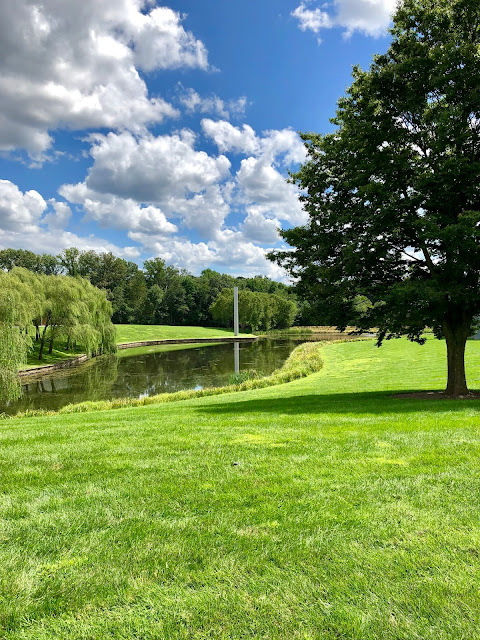Glenstone is an art museum/nature preserve (my definition) in Potomac, Maryland. Entrance is completely free, though you have to reserve your tickets two months in advance. There are limited slots so you have to pounce when the first of the month hits. If I'm being frank, I thought it would be a little more exclusive than it was. For a space that's meant to be appreciated by a few at a time, there were more people there than I would've preferred!
We got so incredibly lucky. It was an unseasonably comfortable late August day. Glenstone very thoughtfully provides umbrellas outside every building on site. I'm sure they're mostly meant for a rainy day but when I saw people using them to shield themselves from the sun, I followed suit.
There's a cafe with robust menu options and formal seating at long tables and a patio that offers some light refreshments and casual indoor and outdoor seating. These items are not complimentary and in fact, are a bit pricey so that must be how they recoup some of their costs. We took a short break at the patio to rehydrate before continuing our explorations.
There are several outdoor sculptures and then there are the indoor pavilions that house other contemporary art. We started our afternoon circling the perimeter of the property seeing all the sculptures first and then ended our day in the pavilions.
There's almost no signage anywhere except to give credit to the artists. This is done purposely so that the art is open to interpretation. On the one hand, we really liked that. We had a lot of fun discussing the garden sculptures/installations but once inside the pavilions it was a little harder to interpret the art without any context.
The docents were dressed in gray, loose, nondescript outfits. They're there to answer questions and talk about the art but the idea is that they're meant to fade into the background and not distract from the art. Or at least, that was my interpretation.
This made me think of a weird spider or "the scrambler" ride at a fair or amusement park.
Evan and I really enjoyed talking about this sculpture. It seems straight-forward but we dove deep into analysis. I noticed that the guy looks like he's holding reins that aren't there. I interpreted that to possibly mean that he thinks he's in control when he's not. Evan took it further and said that maybe no one's in control and the horse and the rider are working in conjunction; there are no reins because no one needs to be in control or controlled.
This was cool because as you walked in/around this very small maze your voice diminished from a loud echo. It was closed-off at the start and then open at the end. Maybe it's a reflection of people; the louder you are, the less you listen and the quieter you are, the better you listen. The less you listen the more closed you are and the more you listen the more open you are.
This was one of the more interesting installations as it was audio in nature. This was a representation of the forest for a thousand years. We sat and listened for 10-15 minutes though I think there was about thirty minutes of audio. We heard rainfall, horses, tree-cutting, construction, cannons, gunfire, airplanes, and Gregorian chanting (or something similar). The man-made noises were particularly jarring and disruptive. What I liked though was that while we heard those awful sounds we were looking at the forest and it didn't move, change, or go anywhere. I hope that the message of this piece is that the forest will prevail with or without human interference or in spite of it.
This was the last of a three-part series of clay art. All three "sculptures" were in their own little houses. The first was a giant ball of clay, in the second house the clay covered the floor, walls, and ceiling and the last house had this three-dimensional seashell-like clay piece against the back wall. I think the idea is that the clay is constantly changing (and cracking) with the weather so it's transformative art.
There were grasshoppers, caterpillars, and butterflies everywhere! Glenstone is extremely proactive about preserving and boosting the surrounding waterways, ecosystems, flora, and fauna. It's part of their environmental mission.
We preferred exploring the grounds and outdoor sculptures to the indoor museum. Some of the interior art was interesting and worth discussion but some of it lost me because it was the kind of contemporary "art" that gives it a bad name - blank untitled canvases, for instance.
All in all, it was a wonderful, contemplative, and relaxing experience and one we'd like to repeat. It was an adults-only outing as Glenstone prohibits children under the age of twelve. I'd like to go there again when the trails are fully functional and we can focus solely on walking around and taking our time to sit and absorb it all. What a gift to the public!















